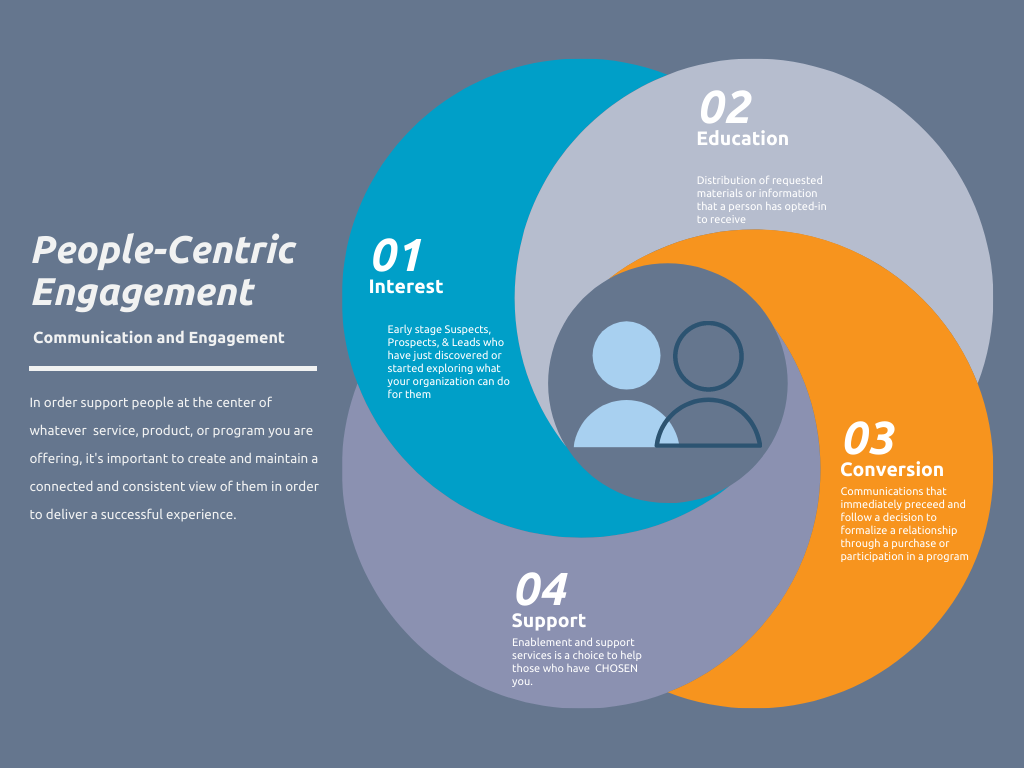
Throughout my career, conversations around an organizations CRM (aka Customer Relationship Management system) have referred to it as the system of record (SOR) or source of truth (SOT). These terms are not always interchangeable. For the purpose of this post, I will consider them one in the same, SOR/T for short. Next, I will define what is a system of engagement and how it relates to CRM.
For all intents and purposes, The Salesforce Marketing Cloud is a communication and engagement platform used to share information through various channels to engage with your audience (customers, constituents, students, patients, donors, and . . . you get the picture that this list can go on for a while). What it is NOT, is the single source of truth for any one individual. It can, however, be the single source of digital engagement. It can even support traditional offline communications, but that is conversation for another day.
Regardless of the channel of communication, people expect a consistent experience and at minimum for you to get their name right, should you choose to personalize your messages. Email, mobile, or any communication channel for that matter, should leverage the same view of the person to whom they are delivering messages.
Your system of engagement isn’t just for marketing. For more on this topic, refer to my post titled End the Marketing Cloud. Just like channels shouldn’t matter, the stage that each person chooses to engage with you should not prevent you from delivering consistent communications where, different parts of your organization are aware of what has happen so far and should be able to make informed decisions when responding to or initiating a conversation. For example, if a person has requested support with a product/service, it would make sense not cross/up-sell something else before you have resolved their concern. Similarly, if I just bought something, I hope I’m not immediately bombarded with ads everywhere I go to buy the thing I just bought! In cases where I just donated to a cause, does it really makes sense to hit me up immediately after with another a request for more money?
The point is your CRM and SOE should be connected with each other, and connected with other systems, as needed, to ensure the best possible view of the people who have chosen your organization. They are not obligated to choose you and you should not assume they always will. Do what you can to connect the fragments of their profile so that you can thoughtfully utilize it to deliver and respond with timely messages for any and all relevant occasions.
Even if you have all your systems mapped and documented with respect to how your systems are connected, have you mapped out the various touch points between you and those who have engaged with you? Are these reflected in your overall architecture? Are there any gaps or areas of opportunity to improve profile accuracy? As automated as society has become, people still expect people to be on the other end. That is why it’s important to put as much care and thought into your system of engagement as your system of record or source truth.


 I recently shared a family vacation at Disney. If any business understands the customer experience, it has to be the iconic mouse and his pals. Disney realizes that we have options. The reason people travel to Disney from all over the world Disneyland or World is for the experience. If it was only about the rides, then no one make the yearly pilgrimage that many make as there are plenty of amusement parks that are much closer to home and likely cheaper, yet people save much of their holiday funds to visit that magical castle. Disney understands that my experience is paramount to building and maintaining a relationship that makes me say, “That was AMAZING and I want to do that again!” and hope that I will share my raving review with friends and family. During my visit the following quote from
I recently shared a family vacation at Disney. If any business understands the customer experience, it has to be the iconic mouse and his pals. Disney realizes that we have options. The reason people travel to Disney from all over the world Disneyland or World is for the experience. If it was only about the rides, then no one make the yearly pilgrimage that many make as there are plenty of amusement parks that are much closer to home and likely cheaper, yet people save much of their holiday funds to visit that magical castle. Disney understands that my experience is paramount to building and maintaining a relationship that makes me say, “That was AMAZING and I want to do that again!” and hope that I will share my raving review with friends and family. During my visit the following quote from